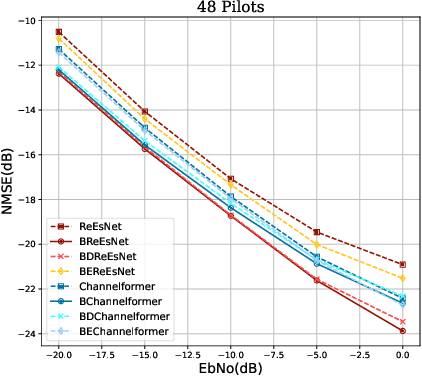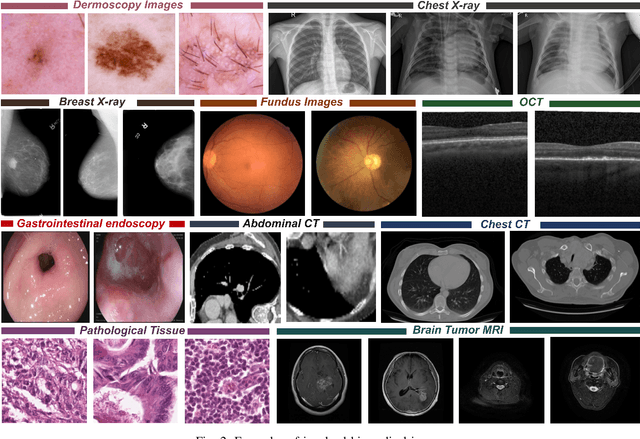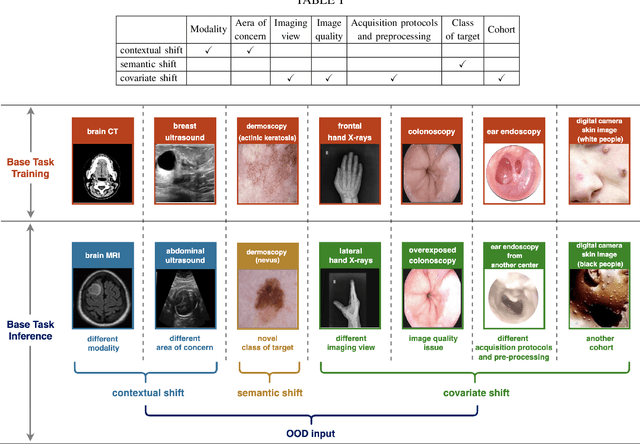Jialong Xu
Belief Information based Deep Channel Estimation for Massive MIMO Systems
Jun 23, 2024



Abstract:In the next generation wireless communication system, transmission rates should continue to rise to support emerging scenarios, e.g., the immersive communications. From the perspective of communication system evolution, multiple-input multiple-output (MIMO) technology remains pivotal for enhancing transmission rates. However, current MIMO systems rely on inserting pilot signals to achieve accurate channel estimation. As the increase of transmit stream, the pilots consume a significant portion of transmission resources, severely reducing the spectral efficiency. In this correspondence, we propose a belief information based mechanism. By introducing a plug-and-play belief information module, existing single-antenna channel estimation networks could be seamlessly adapted to multi-antenna channel estimation and fully exploit the spatial correlation among multiple antennas. Experimental results demonstrate that the proposed method can either improve 1 ~ 2 dB channel estimation performance or reduce 1/3 ~ 1/2 pilot overhead, particularly in bad channel conditions.
Out-of-distribution Detection in Medical Image Analysis: A survey
Apr 28, 2024



Abstract:Computer-aided diagnostics has benefited from the development of deep learning-based computer vision techniques in these years. Traditional supervised deep learning methods assume that the test sample is drawn from the identical distribution as the training data. However, it is possible to encounter out-of-distribution samples in real-world clinical scenarios, which may cause silent failure in deep learning-based medical image analysis tasks. Recently, research has explored various out-of-distribution (OOD) detection situations and techniques to enable a trustworthy medical AI system. In this survey, we systematically review the recent advances in OOD detection in medical image analysis. We first explore several factors that may cause a distributional shift when using a deep-learning-based model in clinic scenarios, with three different types of distributional shift well defined on top of these factors. Then a framework is suggested to categorize and feature existing solutions, while the previous studies are reviewed based on the methodology taxonomy. Our discussion also includes evaluation protocols and metrics, as well as the challenge and a research direction lack of exploration.
Deep Joint CSI Feedback and Multiuser Precoding for MIMO OFDM Systems
Apr 25, 2024Abstract:The design of precoding plays a crucial role in achieving a high downlink sum-rate in multiuser multiple-input multiple-output (MIMO) orthogonal frequency-division multiplexing (OFDM) systems. In this correspondence, we propose a deep learning based joint CSI feedback and multiuser precoding method in frequency division duplex systems, aiming at maximizing the downlink sum-rate performance in an end-to-end manner. Specifically, the eigenvectors of the CSI matrix are compressed using deep joint source-channel coding techniques. This compression method enhances the resilience of the feedback CSI information against degradation in the feedback channel. A joint multiuser precoding module and a power allocation module are designed to adjust the precoding direction and the precoding power for users based on the feedback CSI information. Experimental results demonstrate that the downlink sum-rate can be significantly improved by using the proposed method, especially in scenarios with low signal-to-noise ratio and low feedback overhead.
Swin Transformer-Based CSI Feedback for Massive MIMO
Jan 12, 2024Abstract:For massive multiple-input multiple-output systems in the frequency division duplex (FDD) mode, accurate downlink channel state information (CSI) is required at the base station (BS). However, the increasing number of transmit antennas aggravates the feedback overhead of CSI. Recently, deep learning (DL) has shown considerable potential to reduce CSI feedback overhead. In this paper, we propose a Swin Transformer-based autoencoder network called SwinCFNet for the CSI feedback task. In particular, the proposed method can effectively capture the long-range dependence information of CSI. Moreover, we explore the impact of the number of Swin Transformer blocks and the dimension of feature channels on the performance of SwinCFNet. Experimental results show that SwinCFNet significantly outperforms other DL-based methods with comparable model sizes, especially for the outdoor scenario.
A Comprehensive Study of PAPR Reduction Techniques for Deep Joint Source Channel Coding in OFDM Systems
Sep 21, 2023Abstract:Recently, deep joint source channel coding (DJSCC) techniques have been extensively studied and have shown significant performance with limited bandwidth and low signal to noise ratio. Most DJSCC work considers discrete-time analog transmission, while combining it with orthogonal frequency division multiplexing (OFDM) creates serious high peak-to-average power ratio (PAPR) problem. This paper conducts a comprehensive analysis on the use of various OFDM PAPR reduction techniques in the DJSCC system, including both conventional techniques such as clipping, companding, SLM and PTS, and deep learning-based PAPR reduction techniques such as PAPR loss and clipping with retraining. Our investigation shows that although conventional PAPR reduction techniques can be applied to DJSCC, their performance in DJSCC is different from the conventional split source channel coding. Moreover, we observe that for signal distortion PAPR reduction techniques, clipping with retraining achieves the best performance in terms of both PAPR reduction and recovery accuracy. It is also noticed that signal non-distortion PAPR reduction techniques can successfully reduce the PAPR in DJSCC without compromise to signal reconstruction.
Ultrafast-and-Ultralight ConvNet-Based Intelligent Monitoring System for Diagnosing Early-Stage Mpox Anytime and Anywhere
Aug 25, 2023Abstract:Due to the lack of more efficient diagnostic tools for monkeypox, its spread remains unchecked, presenting a formidable challenge to global health. While the high efficacy of deep learning models for monkeypox diagnosis has been demonstrated in related studies, the overlook of inference speed, the parameter size and diagnosis performance for early-stage monkeypox renders the models inapplicable in real-world settings. To address these challenges, we proposed an ultrafast and ultralight network named Fast-MpoxNet. Fast-MpoxNet possesses only 0.27M parameters and can process input images at 68 frames per second (FPS) on the CPU. To counteract the diagnostic performance limitation brought about by the small model capacity, it integrates the attention-based feature fusion module and the multiple auxiliary losses enhancement strategy for better detecting subtle image changes and optimizing weights. Using transfer learning and five-fold cross-validation, Fast-MpoxNet achieves 94.26% Accuracy on the Mpox dataset. Notably, its recall for early-stage monkeypox achieves 93.65%. By adopting data augmentation, our model's Accuracy rises to 98.40% and attains a Practicality Score (A new metric for measuring model practicality in real-time diagnosis application) of 0.80. We also developed an application system named Mpox-AISM V2 for both personal computers and mobile phones. Mpox-AISM V2 features ultrafast responses, offline functionality, and easy deployment, enabling accurate and real-time diagnosis for both the public and individuals in various real-world settings, especially in populous settings during the outbreak. Our work could potentially mitigate future monkeypox outbreak and illuminate a fresh paradigm for developing real-time diagnostic tools in the healthcare field.
Mpox-AISM: AI-Mediated Super Monitoring for Forestalling Monkeypox Spread
Mar 17, 2023Abstract:The challenge on forestalling monkeypox (Mpox) spread is the timely, convenient and accurate diagnosis for earlystage infected individuals. Here, we propose a remote and realtime online visualization strategy, called "Super Monitoring" to construct a low cost, convenient, timely and unspecialized diagnosis of early-stage Mpox. Such AI-mediated "Super Monitoring" (Mpox-AISM) invokes a framework assembled by deep learning, data augmentation and self-supervised learning, as well as professionally classifies four subtypes according to dataset characteristics and evolution trend of Mpox and seven other types of dermatopathya with high similarity, hence these features together with reasonable program interface and threshold setting ensure that its Recall (Sensitivity) was beyond 95.9% and the specificity was almost 100%. As a result, with the help of cloud service on Internet and communication terminal, this strategy can be potentially utilized for the real-time detection of earlystage Mpox in various scenarios including entry-exit inspection in airport, family doctor, rural area in underdeveloped region and wild to effectively shorten the window period of Mpox spread.
Deep Joint Source-Channel Coding for Semantic Communications
Dec 05, 2022Abstract:Semantic communications is considered as a promising technology for reducing the bandwidth requirements of next-generation communication systems, particularly targeting human-machine interactions. In contrast to the source-agnostic approach of conventional wireless communication systems, semantic communication seeks to ensure that only the relevant information for the underlying task is communicated to the receiver. A prominent approach to semantic communications is to model it as a joint source-channel coding (JSCC) problem. Although JSCC has been a long-standing open problem in communication and coding theory, remarkable performance gains have been shown recently over existing separate source and channel coding systems, particularly in low-latency and low-power scenarios, typically encountered in edge intelligence applications. Recent progress is thanks to the adoption of deep learning techniques for JSCC code design, which are shown to outperform the concatenation of state-of-the-art compression and channel coding schemes, each of which is a result of decades-long research efforts. In this article, we present an adaptive deep learning based JSCC (DeepJSCC) architecture for semantic communications, introduce its design principles, highlight its benefits, and outline future research challenges that lie ahead.
Deep Joint Source-Channel Coding for CSI Feedback: An End-to-End Approach
Apr 07, 2022



Abstract:The increased throughput brought by MIMO technology relies on the knowledge of channel state information (CSI) acquired in the base station (BS). To make the CSI feedback overhead affordable for the evolution of MIMO technology (e.g., massive MIMO and ultra-massive MIMO), deep learning (DL) is introduced to deal with the CSI compression task. Based on the separation principle in existing communication systems, DL based CSI compression is used as source coding. However, this separate source-channel coding (SSCC) scheme is inferior to the joint source-channel coding (JSCC) scheme in the finite blocklength regime. In this paper, we propose a deep joint source-channel coding (DJSCC) based framework for the CSI feedback task. In particular, the proposed method can simultaneously learn from the CSI source and the wireless channel. Instead of truncating CSI via Fourier transform in the delay domain in existing methods, we apply non-linear transform networks to compress the CSI. Furthermore, we adopt an SNR adaption mechanism to deal with the wireless channel variations. The extensive experiments demonstrate the validity, adaptability, and generality of the proposed framework.
 Add to Chrome
Add to Chrome Add to Firefox
Add to Firefox Add to Edge
Add to Edge